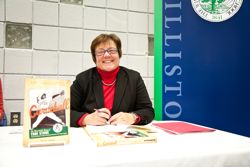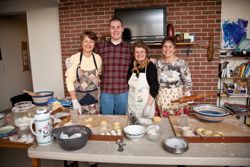 “We are more authentically human when we embrace diversity,” Mount Holyoke College professor Martha Ackmann told the assembled Williston Northampton School community at the start of the 10th annual Diversity Day.
“We are more authentically human when we embrace diversity,” Mount Holyoke College professor Martha Ackmann told the assembled Williston Northampton School community at the start of the 10th annual Diversity Day.
The day would be filled with a variety of workshops—on everything from cyber bullying and Islamic awareness to Zumba and hip hop. But the morning was devoted to a trailblazer from the past: Toni Stone, a female baseball player whose grit and determination in the face of racism was on the leading edge of the civil rights movement.
See the full photo gallery from Diversity Day.
Ackmann had discovered Stone’s story while researching a book and then wrote about her in the biography Curveball: The Remarkable Story of Toni Stone, the First Woman to Play Professional Baseball in the Negro League.
Ackmann, who teaches in the college’s gender studies and English departments, described Stone as “an oddball girl, a remarkable athlete.”
The tale of Stone’s courage and persistence in the face of discrimination was “as much a story about Jim Crowe America as it is about baseball, “ Ackmann said.
Ackmann urged Williston Northampton students to pursue their passions—just like Stone, who never allowed bigotry to diminish her love of baseball.
“Passion, identity, purpose. They all go hand-in-hand, don’t they,” Ackmann said.
“I hope you never allow someone to take away your love of the game—whatever the game is.”
Following the keynote, students headed to affinity group discussions, while faculty attended five adult workshops.
In “Confucianism and East Asian Students,” Ann Prescott, director of the Five College Center for East Asian Studies, explained the ins and outs of an imperial Chinese education.
Within such a system, education was valued over fame, Prescott explained. She lowered her hand to the floor. “Michael Jackson,” she said. Then, “Me!” and raised her hand above her head.
In John Wright House, teachers staggered across the common room under massive, but invisible burdens. Some were wrung their hands, others shook their heads, and still others hurried to one another and said, “I’m so glad you came. Thank you very much.”
“Woe is me,” said one teacher, collapsing to the floor.
“When I clap my hands, you’re going to come back to yourself,” said storyteller Rona Leventhal, who was leading the session, “Story Bag: Tales for Advisory.” While teachers formed groups to discuss the visualization exercise, Leventhal said the idea was to show how storytelling could be used in other situations.
“The goal in the workshop is to make people aware of what stories exist, how they can be used and where to find them,” she said.
There were 21 workshops during the afternoon. Reed Campus Center, the site of many of them, became a particularly lively hub of activity. Small groups formed in Room 103 to quietly work on Kamishibai or paper theater projects; down the hall, students played iron gankoqui bells, a Ghanian instrument, with a rhythmic tak-tak-tak, for a class on West African drumming.
In the Dodge Room, history and global studies teacher Glenn Swanson ‘64 took students through the philosophy of leadership.
“If you want to be a leader, you want to make sure you speak the truth and aren’t afraid of it,” he said.
The loudest workshop by far, though, was “So You Think You Know Hip-Hop?” in the Stu Bop. There, a crowd of enthusiastic dancers, led by Adrian Mendoza ‘12 and Marcus Ware, learned three short dance sequences and free-styled, some even posing and going into headstands.
The hip-hoppers were so enthusiastic that they began to draw onlookers. Students, whose workshops had ended, lined the rails above the Stu Bop and cheered for the impromptu performers.
The group in the Choo family apartment was less noisy, but no less enthusiastic. Students lounged on couches and chairs, eating plates of dumplings and sauerkraut. Mike Volpe ’13 shaped pierogi dough on a counter covered with jars of flour, cracked eggs, and cheese.
Volpe said he made pierogi every Christmas with his grandmother, so a pierogi-making workshop was a perfect cultural fit.
“I loved it,” Volpe said. “This is all I’ve been looking forward to all day.”


